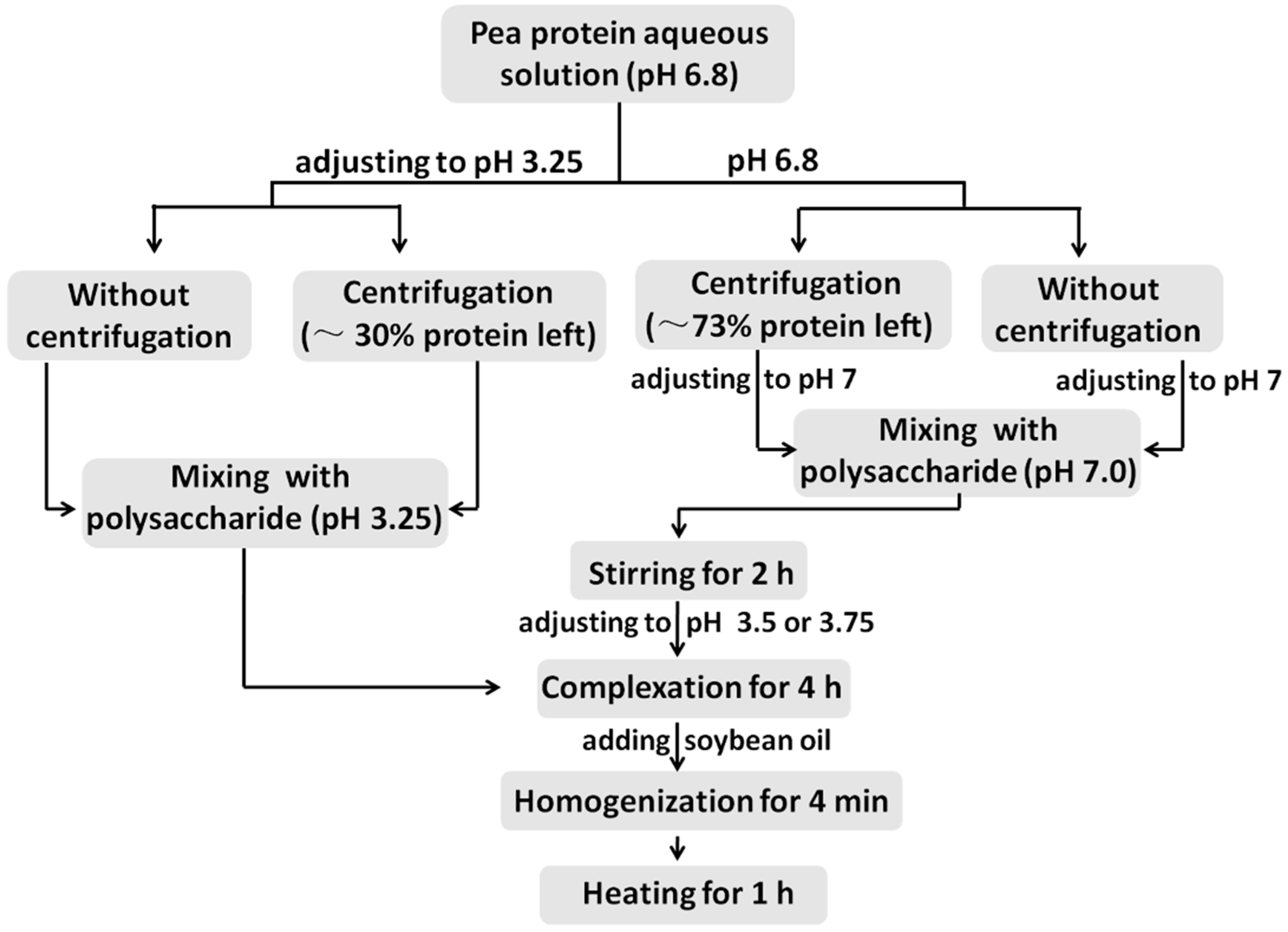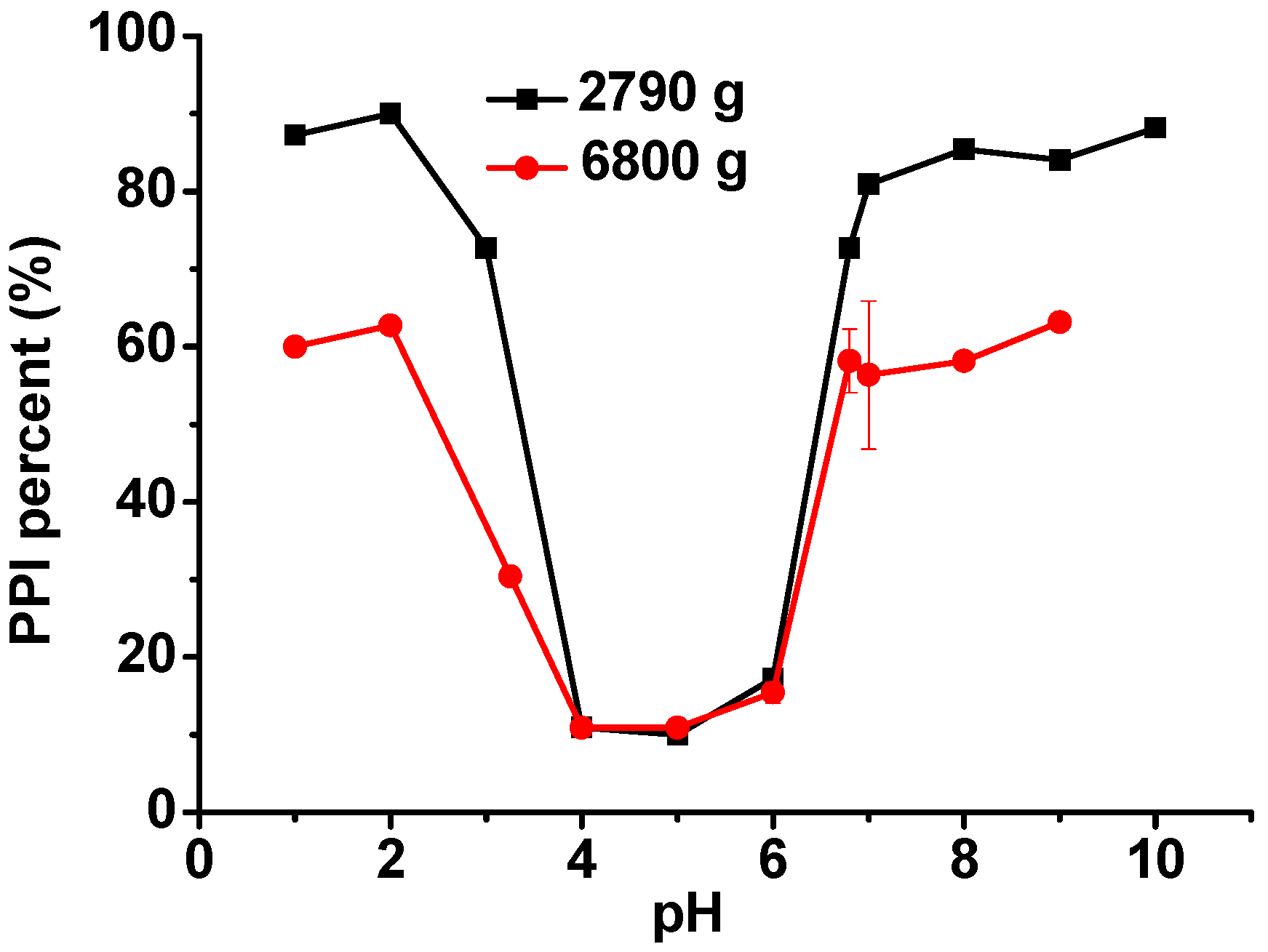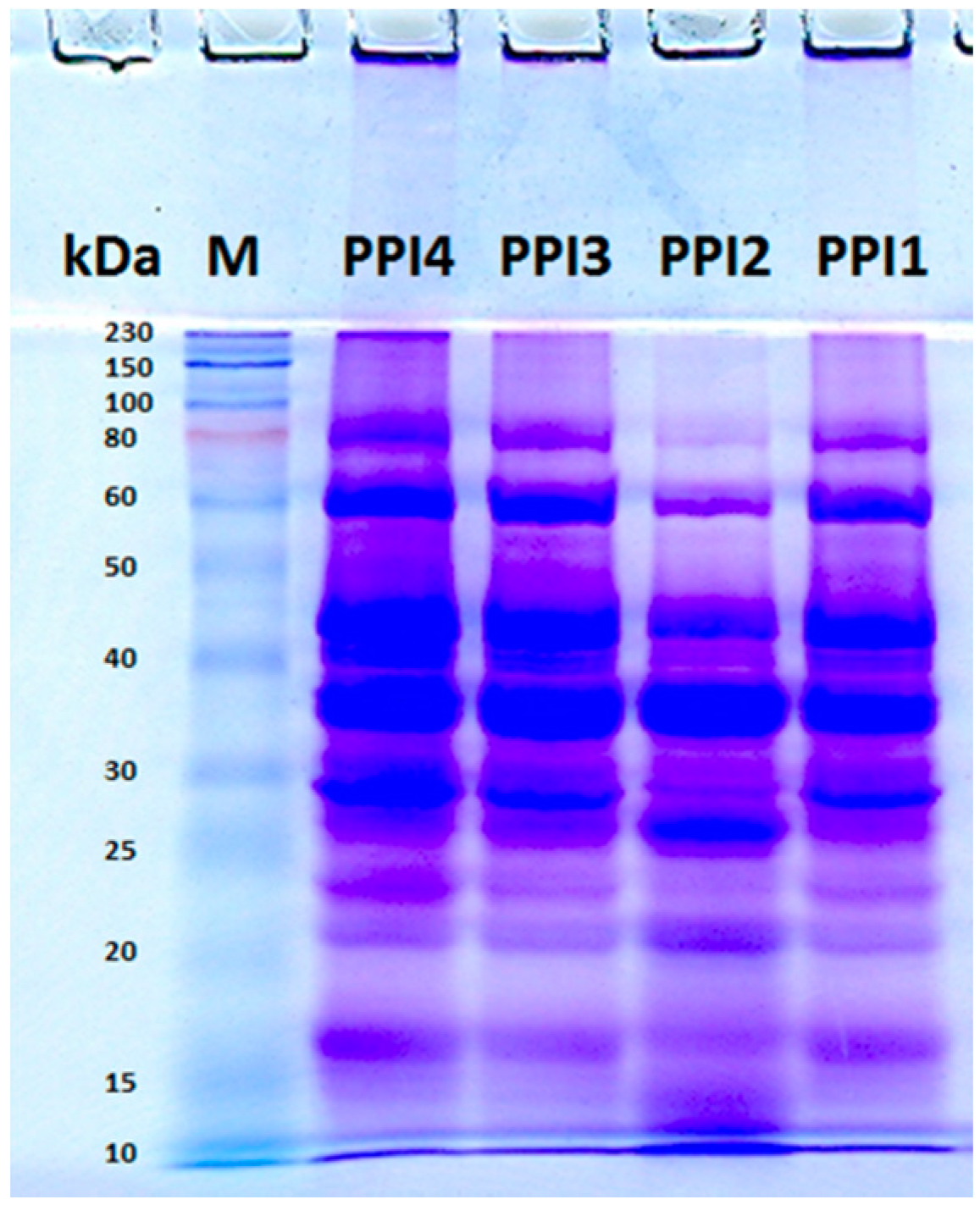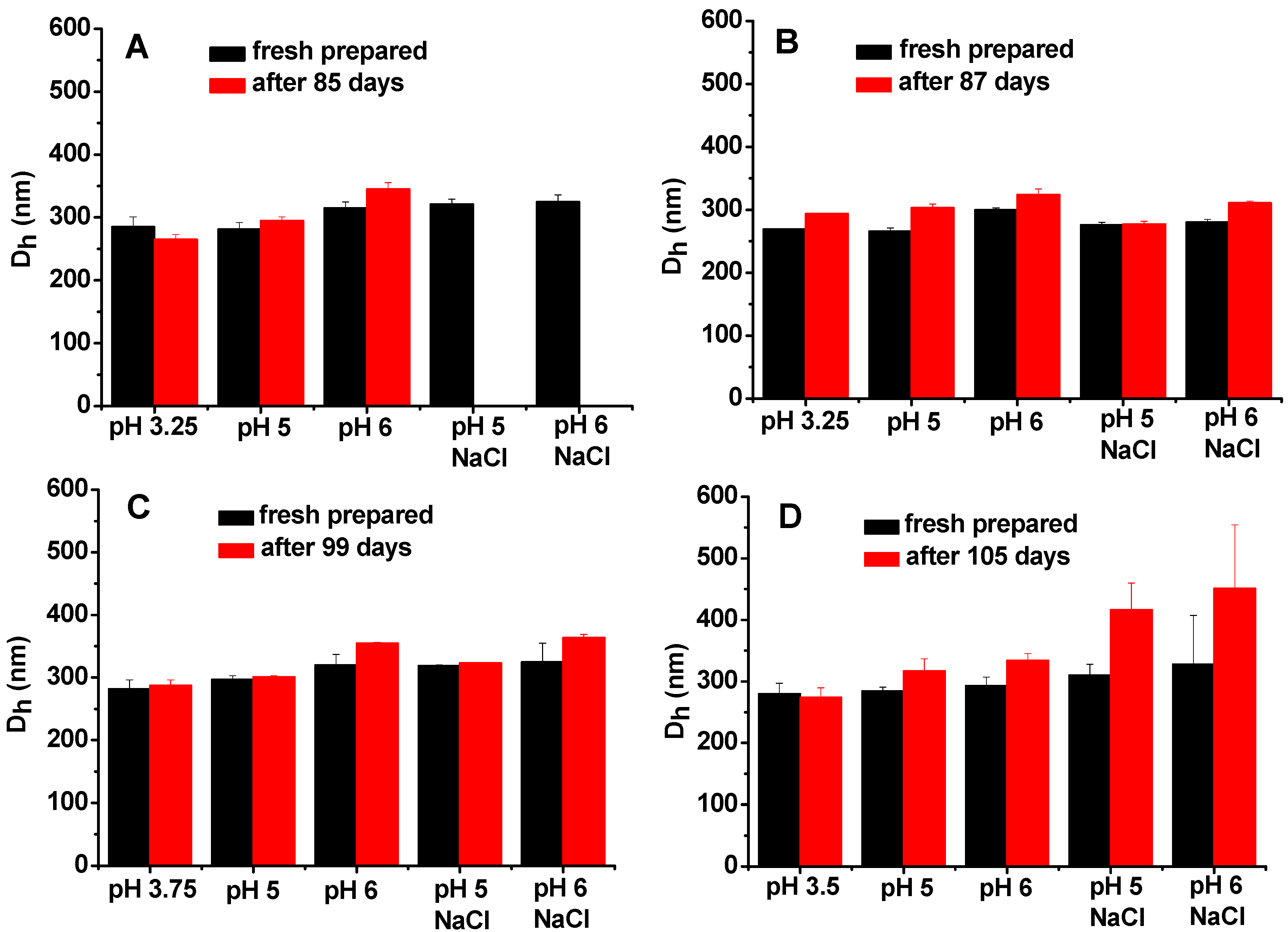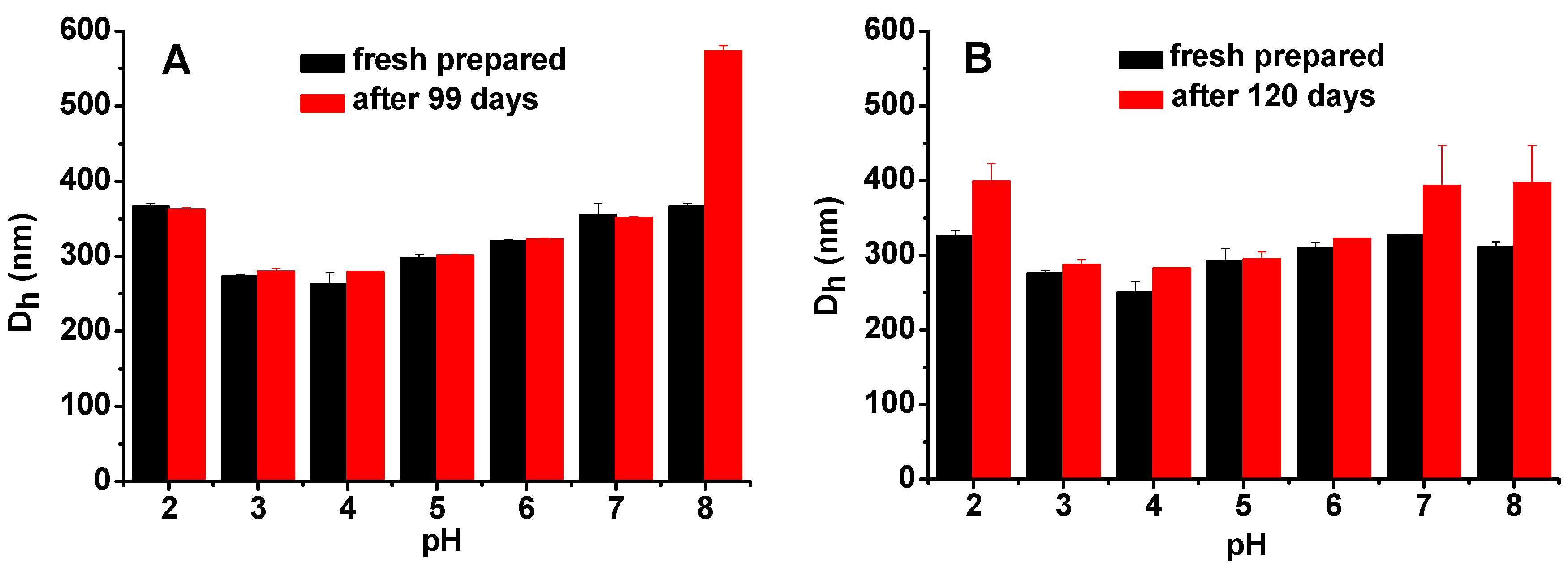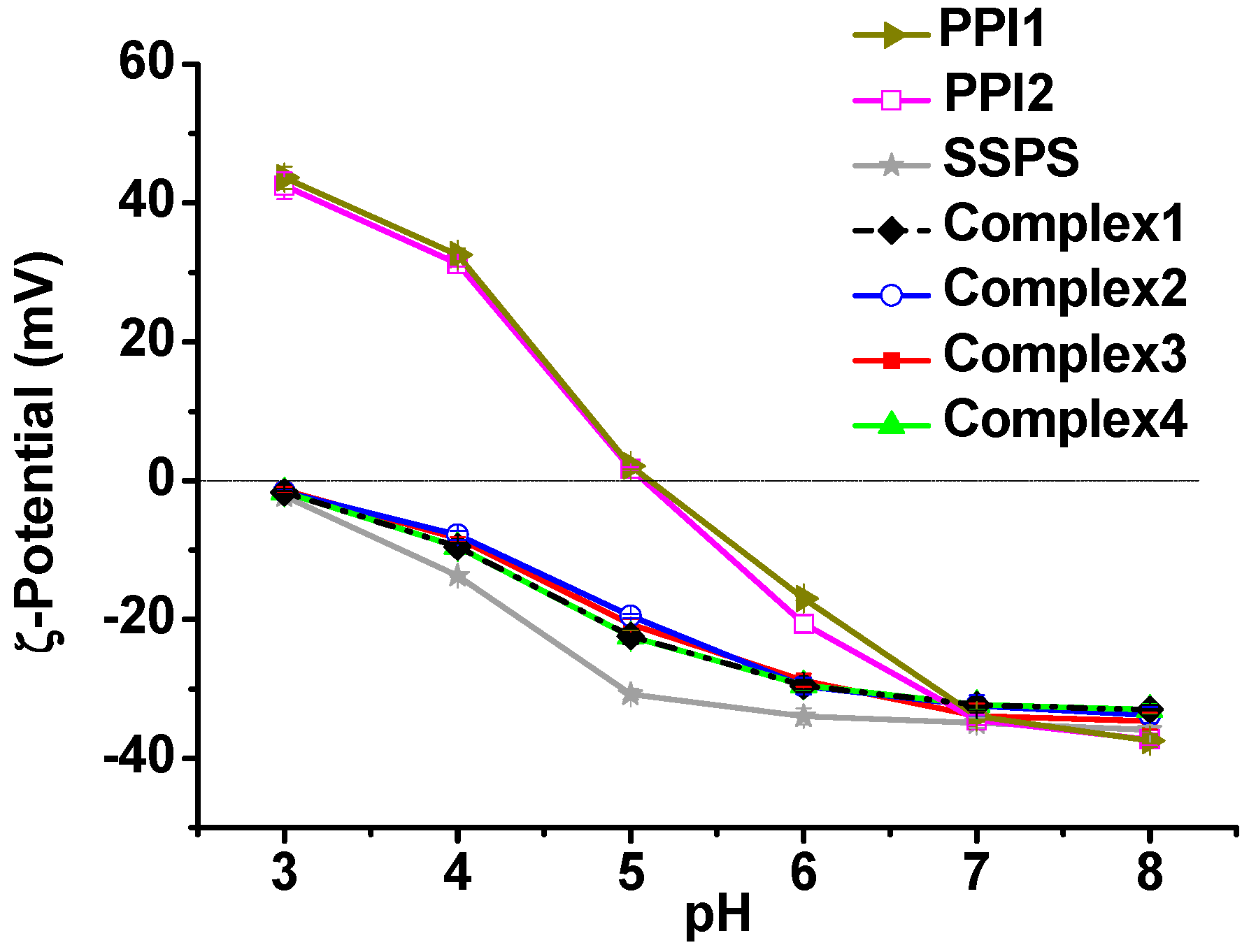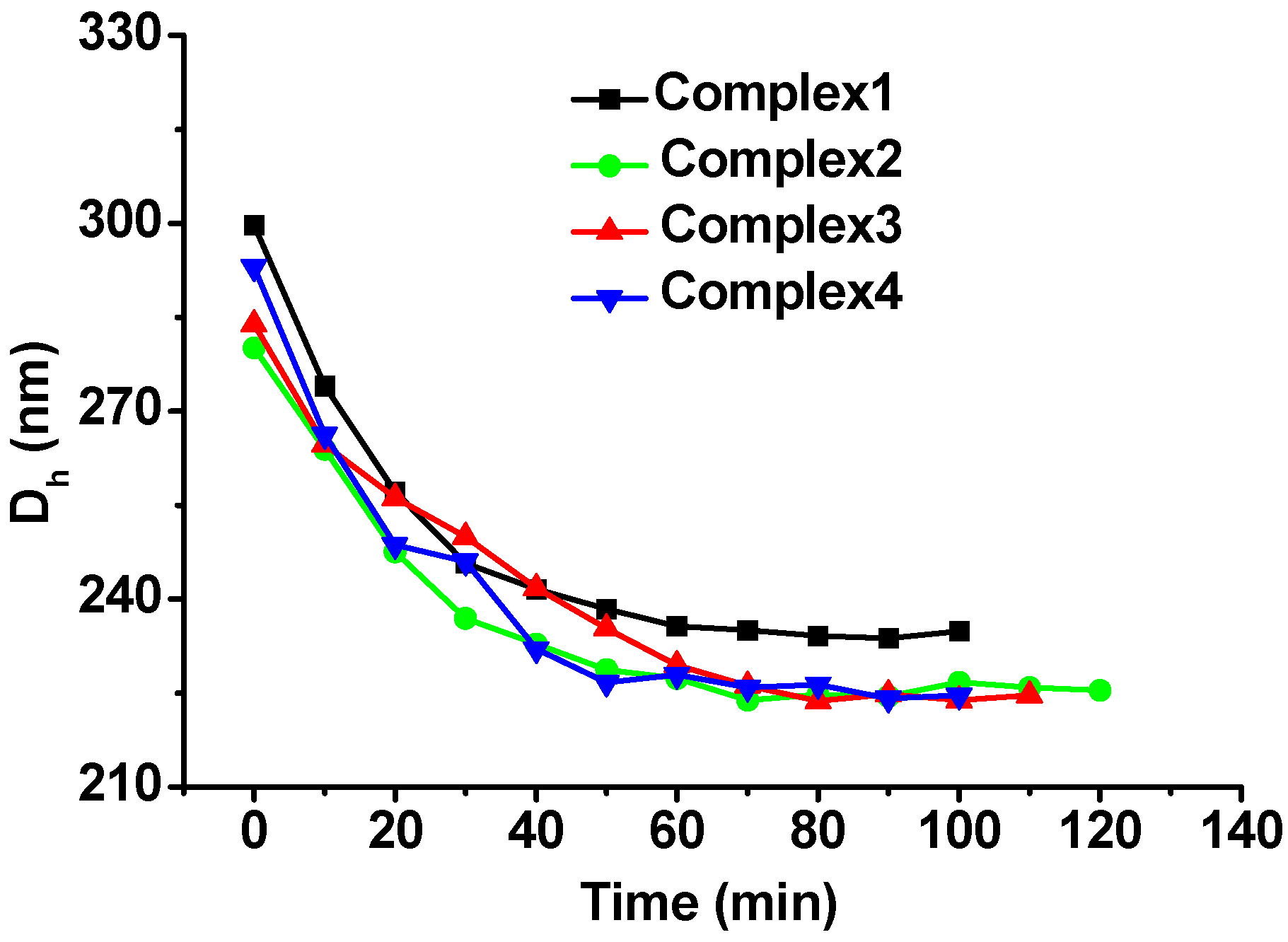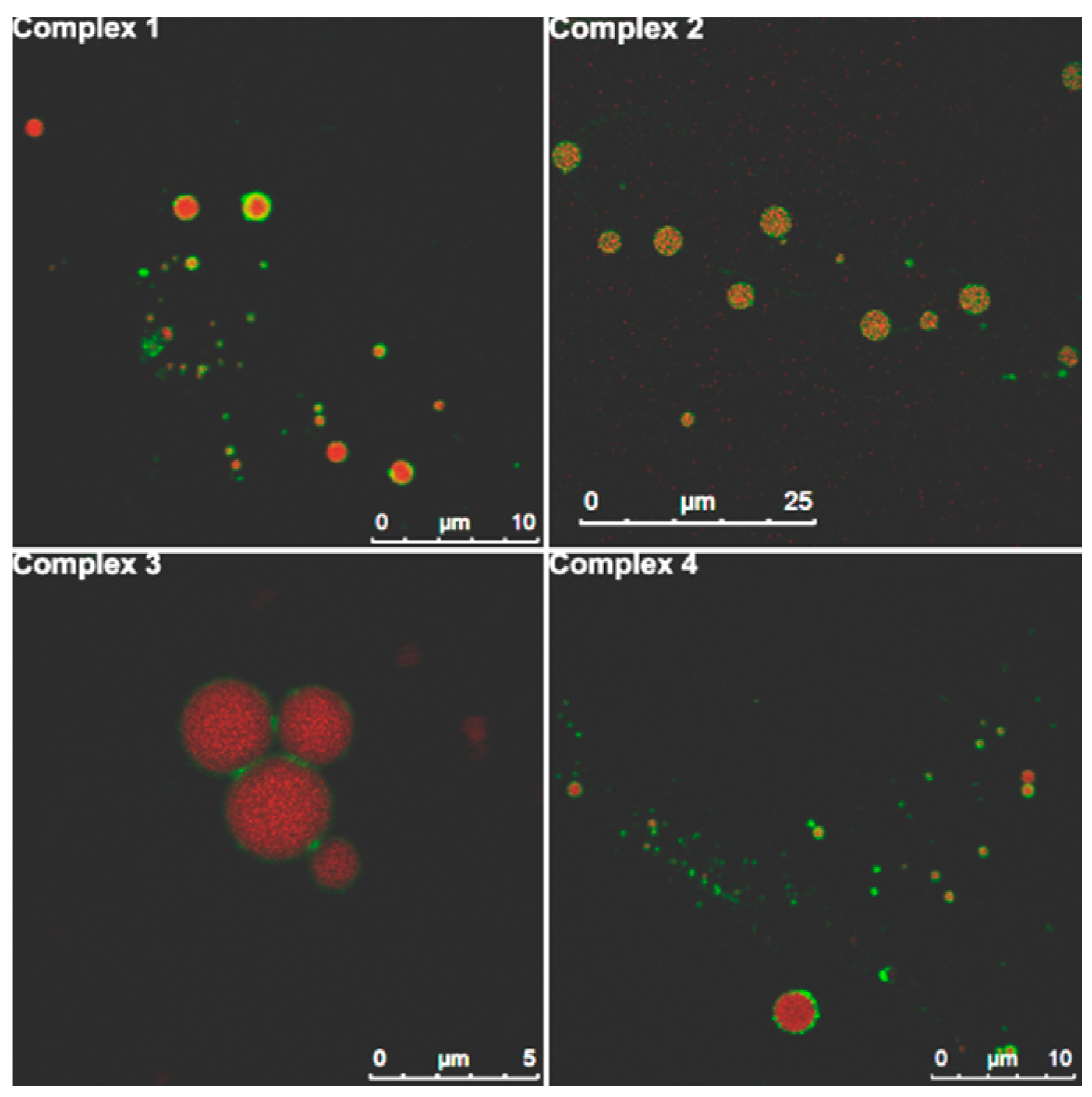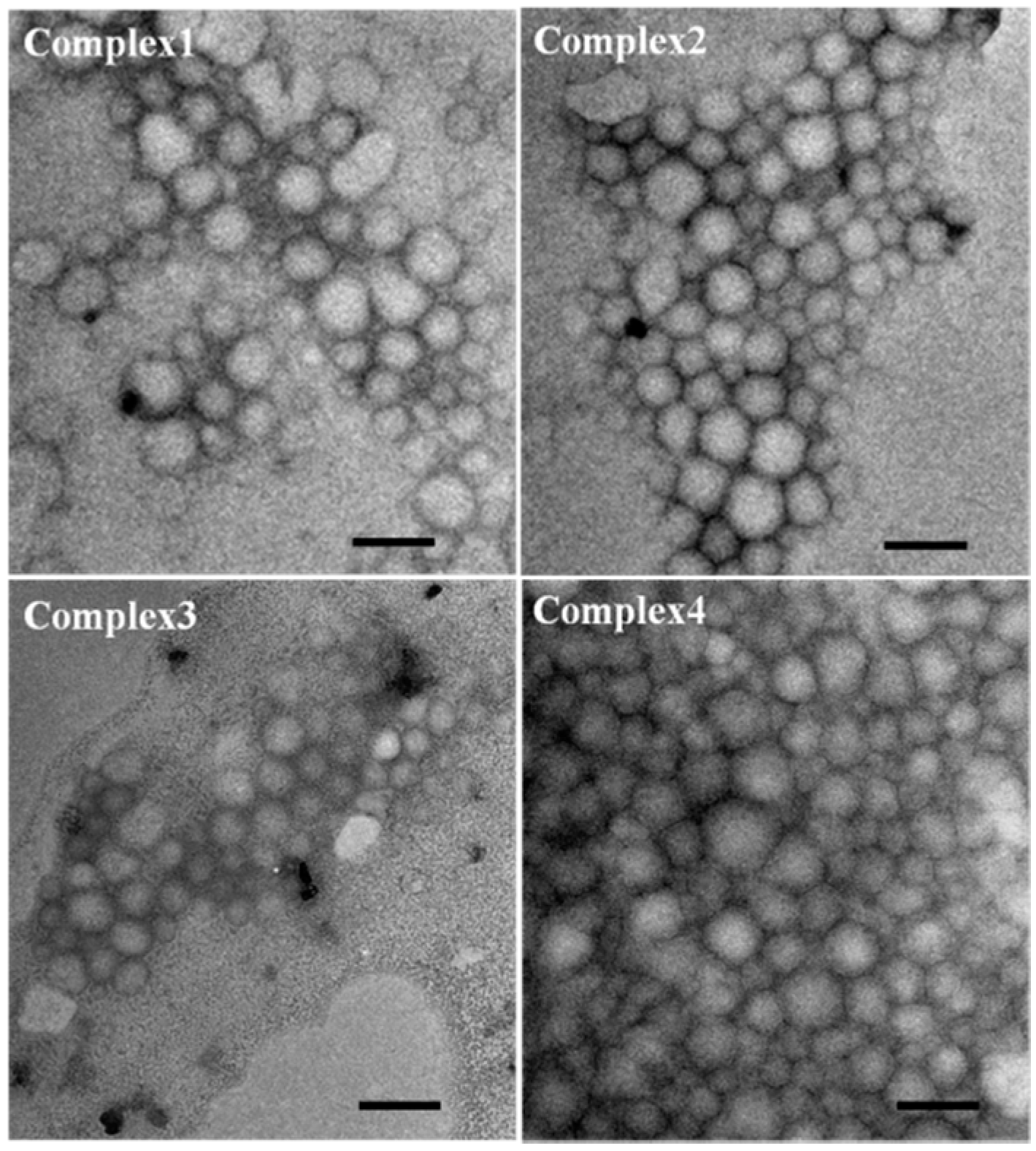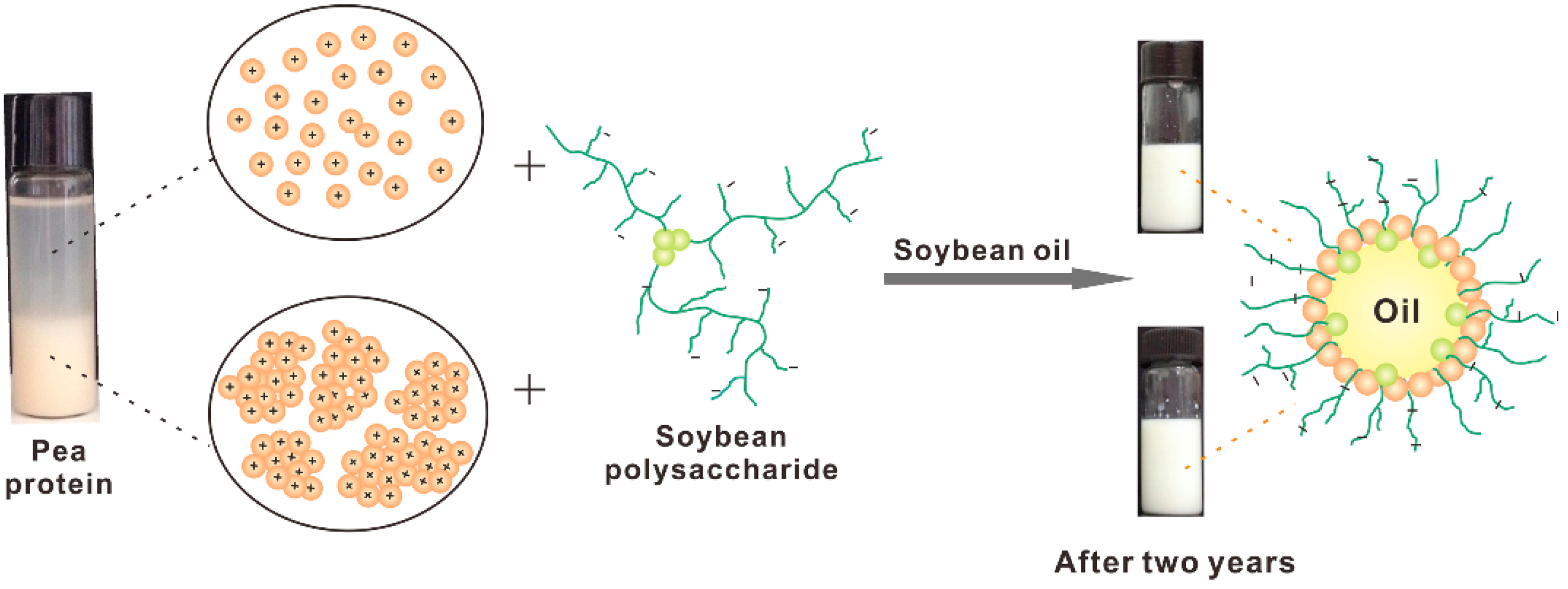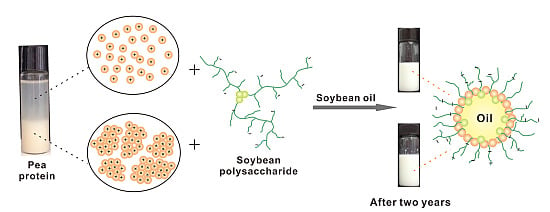2.1. Properties of PPI, SSPS, and PPI/SSPS Complex Solutions
Firstly, the aggregation behaviors of PPI dispersed in different pH aqueous solutions were investigated. After centrifugation at pH 4, 5, and 6, only about 10% of the PPI remains in the solutions as shown in
Figure 1, confirming that most of the PPI is insoluble at pH values around its pI. The PPI solubility increases when the solution pH is changed from 4 to 2 or from 6 to 10. At pH 2 and 10, about 89% of the PPI remains in the solution after 2790
g centrifugation, while only about 63% of the PPI remains after 6800
g centrifugation. This difference indicates that part of the PPI is still in aggregates, even when the solution pH is far away from its pI, but some of the aggregates are dispersible. In this study, the PPI used was a commercial one in which the aggregates possibly formed during the drying and storage process.
Figure 1.
Remaining PPI percentages in different pH solutions after centrifugation at 2790 g or 6800 g for 30 min.
Figure 1.
Remaining PPI percentages in different pH solutions after centrifugation at 2790 g or 6800 g for 30 min.
Four PPI solutions without and with centrifugation at pH 3.25 and pH 6.8 were prepared as described in
Table 1. The four PPI solutions were analyzed by sodium dodecyl sulfate polyacrylamide gel electrophoresis (SDS-PAGE) under reducing condition. The bands of the PPI samples shown in
Figure 2 are similar to the bands reported in the literature [
30]. PPI1 and PPI4 are the PPI samples without centrifugation; therefore, their bands are identical. PPI3 was obtained by 2790
g centrifugation at pH 6.8, whose bands are not significantly different from the bands of PPI1 and PPI4. PPI2 was obtained by 6800
g centrifugation at pH 3.25. Compared with the other PPI samples, PPI2 contains more components with smaller molecular weights and less components with larger molecular weights. This result indicates that the PPI components with larger molecular weights tend to aggregate at pH 3.25 and they can be removed by centrifugation.
Table 1.
Preparation conditions of various PPI and SSPS stock solutions and PPI/SSPS complex solutions.
Table 1.
Preparation conditions of various PPI and SSPS stock solutions and PPI/SSPS complex solutions.
| Sample | Preparation Condition | PPI Concentration (mg/mL) | SSPS Concentration (mg/mL) |
|---|
| SSPS | pH 7.0 or pH 3.25 | | 50 |
| PPI | pH 6.8 | 50 | |
| PPI1 | Adjusting PPI to pH 3.25 | | |
| PPI2 | Centrifuging PPI1 at 6800 g | | |
| PPI3 | Centrifuging PPI at 2790 g and then adjusting pH to 7.0 | | |
| PPI4 | Adjusting PPI to pH 7.0 | | |
| Complex1 | Mixing PPI1 with SSPS at pH 3.25 | 5 | 25 |
| Complex2 | Mixing PPI2 with SSPS at pH 3.25 | 4 | 25 |
| Complex3 | Mixing PPI3 with SSPS at pH 7.0 and then adjusting pH to 3.75 | 5 | 20 |
| Complex4 | Mixing PPI4 with SSPS at pH 7.0 and then adjusting pH to 3.5 | 5 | 20 |
Figure 2.
SDS-PAGE analysis of the four PPI solutions under reducing condition. Approximately 0.04 mg PPI was loaded in each lane.
Figure 2.
SDS-PAGE analysis of the four PPI solutions under reducing condition. Approximately 0.04 mg PPI was loaded in each lane.
Figure 3 shows the ζ-potentials of PPI1, PPI2, and SSPS in the pH range of 3–8. PPI tends to precipitate at pH values close to its pI. The ζ-potentials of PPI were measured immediately after magnetic stirring, therefore, the ζ-potentials are for reference only. PPI1 is positively charged at pH below 4.8 and negatively charged at pH above 4.8, while the pI of PPI2 shifts to pH 5.2. SSPS carries negative charges at pH above 3. The results in
Figure 3 suggest that PPI1 and PPI2 can form electrostatic complexes with SSPS in the pH ranges of 3–4.8 and 3–5.2, respectively.
Figure 3.
ζ-Potentials of PPI1, PPI2, and SSPS solutions as a function of pH.
Figure 3.
ζ-Potentials of PPI1, PPI2, and SSPS solutions as a function of pH.
PPI, SSPS, and PPI/SSPS complex solutions prepared as described in
Table 1 were investigated using dynamic light scattering (DLS). The PPI and SSPS concentrations in the solutions are shown in
Table 2, which are the same as the concentrations used in emulsification process. The DLS results (
Table 2) reveal that all the samples contain particles. PPI1 tends to precipitate as prepared; the corresponding particle size is about 1540 nm measured immediately after magnetic stirring. PPI2 has a size of about 206 nm because of the removal of larger aggregates by centrifugation. PPI4 shows a size of about 451 nm, substantiating that the aggregates produced at pH 7.0 are smaller than those produced at pH 3.25. SSPS also contains particles due to the aggregation of the naturally conjugated hydrophobic protein. Complex1 solution does not change significantly in appearance and in particle size compared with PPI1, suggesting that by directly mixing PPI aggregates with SSPS at pH where they have opposite charges cannot obtain dispersible PPI/SSPS complex. Complex2 solution displays larger particles than PPI2, but smaller particles than SSPS, suggesting the complexation of SSPS with PPI2. For Complex3 and Complex4 solutions, after respectively mixing PPI3 and PPI4 with SSPS at pH 7.0 and then adjusting the pH to 3.75 and 3.5, no precipitation was observed, confirming the formation of PPI3/SSPS and PPI4/SSPS complexes.
Table 2.
DLS results of PPI, SSPS, and PPI/SSPS complex solutions.
Table 2.
DLS results of PPI, SSPS, and PPI/SSPS complex solutions.
| Sample a | PPI Concentration (mg/mL) | SSPS Concentration (mg/mL) | Without Homogenization | After Homogenization |
|---|
| Dhb (nm) | PDI c | Dhb (nm) | PDI c |
|---|
| SSPS | 0 | 20 | 834 ± 53 | 1.0 | | |
| PPI1 | 5 | 0 | 1540 ± 276 d | 1.0 | | |
| PPI2 | 4 | 0 | 206 ± 8 | 0.60 ± 0.03 | | |
| PPI3 | 5 | 0 | 250 ± 75 | 0.59 ± 0.05 | | |
| PPI4 | 5 | 0 | 451 ± 66 | 1.0 | | |
| Complex1 | 5 | 25 | 1555 ± 455 d | 1.0 | 213 ± 9 e | 0.65 ± 0.04 |
| Complex2 | 4 | 25 | 412 ± 18 | 0.48 ± 0.04 | 192 ± 4 e | 0.44 ± 0.03 |
| Complex3 | 5 | 20 | 580 ± 42 | 0.36 ± 0.03 | 195 ± 8 e | 0.49 ± 0.03 |
| Complex4 | 5 | 20 | 744 ± 88 | 0.57 ± 0.03 | 218 ± 9 e | 0.72 ± 0.02 |
In this study, the emulsions were produced by high pressure homogenization, in which the oil droplets are disrupted by the forces of inertia and shearing in turbulent flow and also cavitation and shear stresses in laminar flow [
31]. We also measured the PPI/SSPS complex solutions after the same high pressure homogenization as the emulsification process. The four complex solutions display similar particles of about 200 nm (
Table 2), which are much smaller than the particles before homogenization. Furthermore, after homogenization, no precipitation was observed within at least one week, demonstrating that the high pressure homogenization disrupts the aggregates of PPI and SSPS and promotes the formation of dispersible PPI/SSPS complexes.
The morphologies of Complex1 and Complex2 before and after homogenization were observed by transmission electron microscopy (TEM). Before the homogenization, large aggregates with micron sizes exist in Complex1 sample (
Figure 4A), whereas no large aggregates exist in Complex2 sample (
Figure 4C) due to the centrifugation of PPI. After homogenization, both Complex1 and Complex2 samples present relatively uniform nanoparticles (
Figure 4B,D). The TEM result is consistent with the DLS result shown in
Table 2, supporting that the high pressure homogenization disrupts the aggregates of PPI and SSPS and promotes the formation of dispersible PPI/SSPS complexes.
Figure 4.
TEM images of Complex1 (A) before and (B) after high pressure homogenization as well as Complex2 (C) before and (D) after high pressure homogenization.
Figure 4.
TEM images of Complex1 (A) before and (B) after high pressure homogenization as well as Complex2 (C) before and (D) after high pressure homogenization.
The flow behaviors of PPI, SSPS, and PPI/SSPS complex solutions as a function of shear rate were investigated and the results are shown in
Figure 5. The four PPI solutions exhibit similar low viscosity behaviors. The reasons may be as follows: (1) the PPI concentration is very low (only 4 mg/mL in PPI2 solution and 5 mg/mL in the other PPI solutions), (2) PPI is globular protein and/or in aggregation state, and (3) the inter-particle interactions are relatively weak which can be broken easily under low shear rates. When the shear rate applied is above 0.1 s
−1, the viscosities of the four PPI solutions are almost the same as the viscosity of water. SSPS solution presents higher viscosity and shear-shinning behavior compared with the PPI solutions. However, the four complex solutions exhibit similarly low viscosity behaviors, distinctively different from the flow behavior of SSPS, indicating that the entanglement and hydrophobic interactions of SSPS have been broken in the complex solutions. Complex1 solution exhibits similar behavior to the other complex solutions, implying that PPI1 can also form complex with SSPS under shear stress despite the existence of large aggregates. The flow behaviors shown in
Figure 5 further support the conclusion above that at acidic condition the PPI aggregates can form complexes with SSPS under shear stress.
Figure 5.
Viscosities of (A) PPI, and (B) SSPS and PPI/SSPS complex solutions as a function of shear rate.
Figure 5.
Viscosities of (A) PPI, and (B) SSPS and PPI/SSPS complex solutions as a function of shear rate.
PPI1 and PPI2 are positively charged in the pH ranges of 3–4.8 and 3–5.2, respectively, and SSPS is negatively charged when the pH is above 3 as shown in
Figure 3. Therefore, electrostatic attraction between PPI and SSPS exists in the pH range of 3.25–3.75. In addition, SSPS contains about 6.3% hydrophobic protein, which can increase the interactions between PPI and SSPS. Before the high pressure homogenization, the self-aggregation of PPI blocks the interactions of PPI with SSPS and large aggregates still exist in Complex1 sample as shown in
Table 2 and
Figure 4A. The PPI aggregates can be disrupted by the shear stress or high pressure homogenization that promotes the interactions of PPI with SSPS. The formation of nano-sized PPI/SSPS complexes after the homogenization prevents the PPI from macroscopical precipitation.
Table 2 and
Figure 4 show that after high pressure homogenization, the PPI/SSPS complexes prepared from PPI with and without aggregates are almost the same; therefore, we can expect that the four complex emulsions produced by high pressure homogenization have similar structure and stability.
2.2. Emulsifying Ability of the Complexes and Stability of the Complex Emulsions
PPI3 alone cannot produce stable emulsions within the pH range of 4–6 which is close to the pI of PPI. The PPI3 emulsions, produced at pH 3 and pH 7 with 5 mg/mL PPI in aqueous solution and 10 v% oil, have sizes of 273 and 398 nm, respectively. The resultant emulsions were adjusted to pH 2–8 and NaCl was added to reach 0.2 M concentration. After that, all the PPI3 emulsions display creaming within one week except for the emulsion produced at pH 3 without pH change and NaCl addition. PPI2 emulsion produced at pH 3 possesses a droplet size of 287 nm and presents similar creaming phenomena as PPI3 emulsion after the pH adjustment and addition of 0.2 M NaCl. Individual PPI1 and PPI4, which contain large aggregates, were also used as emulsifiers to produce emulsions at pH 3. After the homogenization, the PPI1 and PPI4 emulsions are not homogeneous. This result indicates that without SSPS, PPI aggregates alone cannot produce stable emulsion by high pressure homogenization. SSPS emulsion, produced at pH 3.75 with 20 mg/mL SSPS in aqueous solution and 10 v% oil, has much larger droplets than PPI emulsions, and creaming also appears within one week.
Figure 6.
Droplet size changes of (A) Complex1, (B) Complex2, (C) Complex3, and (D) Complex4 emulsions before and after storage at 4 °C in different pH media with or without 0.2 M NaCl.
Figure 6.
Droplet size changes of (A) Complex1, (B) Complex2, (C) Complex3, and (D) Complex4 emulsions before and after storage at 4 °C in different pH media with or without 0.2 M NaCl.
For Complex1 and Complex2, we chose pH 3.25 as the emulsification pH condition. The reasons are as follows: (1) in the pH range of 3–4.8, where PPI and SSPS carry opposite charges, the dispersible fraction of PPI at pH above 3.25 is too low as shown in
Figure 1, and (2) the negative charges of SSPS at pH below 3.25 are too low as shown in
Figure 3. Fresh prepared Complex1 and Complex2 emulsions, which have droplet sizes of 285 and 269 nm (
Figure 6A,B), respectively, were adjusted to pH 5 and 6, and NaCl was added to reach 0.2 M concentration and then the emulsions were stored at 4 °C to investigate the long-term stability. After 85 days of storage, Complex1 emulsions stored at pH 3.25 are homogeneous, while a little whey layer at the bottom as well as increased droplet sizes are noted in the emulsions stored at pH 5 and 6 (
Figure 6A), whereas the emulsions stored at pH 5 and 6 containing 0.2 M NaCl display creaming. Complex2 emulsions remain homogeneous after 87 days of storage at pH 5 and 6 with and without 0.2 M NaCl, suggesting that Complex2 emulsions are more stable than Complex1 emulsions. For Complex3 and Complex4, the optimal emulsification pH conditions are pH 3.75 and pH 3.5, respectively; the emulsions produced at other pH conditions have larger droplets after the pH change and NaCl addition (data not shown). Similarly, fresh prepared Complex3 and Complex4 emulsions with droplet sizes of 282 and 280 nm, respectively, were adjusted to pH 5 and 6, and the NaCl was added to investigate the stability. Complex3 and Complex4 emulsions are homogeneous after 99 and 105 days of the storage, respectively. On the other hand, after storage at pH 5 and 6 with 0.2 M NaCl, more significant changes in droplet size are noted in Complex4 emulsions compared with the changes in Complex 3 emulsions (
Figure 6C,D).
Table 3.
DLS results of PPI, SSPS, and complex emulsions before and after long-term storage in pH 6 with 0.2 M NaCl at 4 °C.
Table 3.
DLS results of PPI, SSPS, and complex emulsions before and after long-term storage in pH 6 with 0.2 M NaCl at 4 °C.
| Sample | SDS Concentration after Dilution (%) a | Dh (nm) | PDI |
|---|
| SSPS | fresh | 0 | 724 ± 12 | 0.62 ± 0.08 |
| after 2 weeks | 0 | 752 ± 23 | 1.0 |
| 0.3 | 699 ± 17 | 0.27 ± 0.09 |
| PPI1 | cannot produce homogeneous emulsion |
| PPI2 | fresh | 0 | 1094 ± 21 | 0.26 ± 0.05 |
| after 1 weeks | 0 | 9025 ± 1008 | 1.0 |
| 0.3 | 798 ± 17 | 0.77 ± 0.04 |
| PPI3 | fresh | 0 | 1138 ± 15 | 0.13 ± 0.05 |
| after 2 weeks | 0 | 8774 ± 198 | 1.0 |
| 0.3 | 736 ± 28 | 0.81 ± 0.02 |
| PPI4 | cannot produce homogeneous emulsion |
| Complex1 | fresh | 0 | 319 ± 8 | 0.27 ± 0.09 |
| after12 months | 0 | 426 ± 26 | 0.14 ± 0.10 |
| 0.3 | 371 ± 20 | 0.16 ± 0.03 |
| Complex2 | fresh | 0 | 283 ± 7 | 0.16 ± 0.05 |
| after 14 months | 0 | 331 ± 24 | 0.12 ± 0.02 |
| 0.3 | 312 ± 12 | 0.16 ± 0.02 |
| Complex3 | fresh | 0 | 325 ± 6 | 0.23 ± 0.06 |
| after 12 months | 0 | 421 ± 28 | 0.25 ± 0.10 |
| 0.3 | 388 ± 2 | 0.24 ± 0.13 |
| Complex3 (unheated) | fresh | 0 | 740 ± 70 | 0.74 ± 0.26 |
| after 12 months | 0 | 3374 ± 245 | 1.0 |
| 0.3 | 404 ± 50 | 0.60 ± 0.17 |
| Complex4 | fresh | 0 | 328 ± 27 | 0.20 ± 0.03 |
| after 11 months | 0 | 482 ± 178 | 0.31 ± 0.14 |
| 0.3 | 404 ± 118 | 0.22 ± 0.09 |
After about 12 months of storage, all four complex emulsions stored in pH 6 medium containing 0.2 M NaCl display a creaming layer. In order to investigate the creaming mechanism during the storage, the creaming layer was analyzed using two methods: (1) the creaming layer was dispersed in water with the same pH and NaCl concentration followed by DLS measurement; (2) the creaming layer was dispersed in water with the same pH and NaCl concentration as well as 0.3% sodium dodecyl sulfate (SDS) followed by DLS measurement. SDS can disrupt the hydrophobic interactions and hydrogen bonding between droplets, thus can dissociate the aggregation/flocculation of the droplets. On the other hand, SDS cannot disrupt disulfide bonds, therefore, it cannot displace the protein and polysaccharide in the oil-water interface if disulfide bonds are involved in the interfacial film [
32,
33].
Table 3 shows the droplet sizes of the creaming layers after storage in pH 6 medium containing 0.2 M NaCl. For PPI2 and PPI3 emulsions, their droplet sizes increase to about 9 μm after short-term storage; however, by dispersing the creaming layer in 0.3% SDS solution, their droplet sizes drop to 798 nm and 736 nm, respectively. This result indicates that the creaming in PPI2 and PPI3 emulsions is mainly caused by the aggregation/flocculation of the droplets. Comparatively, for the four complex emulsions, their droplet sizes do not show significant difference when dispersing the creaming layers in the solutions with and without 0.3% SDS, indicating that the aggregation/flocculation and coalescence of the droplets are not severe after about one year of the storage. As mentioned above, all the emulsions display creaming layer after long-term storage in the media containing 0.2 M NaCl. Furthermore,
Figure 6 shows that most of the samples increase their droplet sizes after the addition of NaCl. As we know, the density increases after the addition of NaCl in aqueous phase and NaCl can screen the electrostatic repulsion of the negatively charged droplets. Possibly, the increase of the density difference between the oil droplets and aqueous phase and the decrease of the electrostatic repulsion lead to the creaming of the complex emulsions in the media containing NaCl.
In this study, all the emulsions were heated at 90 °C for 1 h immediately after emulsification to produce an irreversible PPI/SSPS complex film at oil-water interface, which is similar to soy protein/SSPS emulsions reported previously [
22]. During emulsification process, PPI and SSPS formed complex interfacial film because they have opposite charges as well as both PPI and SSPS have emulsification ability as shown in
Table 3. After heating, PPI gelated [
34,
35] and thus part of the SSPS was embedded in the gelated PPI, which obstructs the dissociation of the complex film even when the PPI and SSPS both carry negative charges. This speculation is proved by the data shown in
Figure 7. All the Complex3 and Complex4 emulsions after storage in the media of pH 2–8 for 99 and 120 days, respectively, are homogeneous. The droplet sizes increase from pH 4 to pH 8 and also from pH 4 to pH 2 due to the decrease of the electrostatic attraction and the increase of the electrostatic repulsion between PPI and SSPS (
Figure 3).
Figure 7 verifies that the heated complex emulsions are stable against pH change and long-term storage.
Figure 7.
Droplet size changes of (A) Complex3 and (B) Complex4 emulsions before and after storage at 4 °C in different pH media without NaCl.
Figure 7.
Droplet size changes of (A) Complex3 and (B) Complex4 emulsions before and after storage at 4 °C in different pH media without NaCl.
We also investigated Complex3 emulsion without heating for comparison.
Table 3 shows that aggregation/flocculation occurs immediately after the fresh prepared emulsion being adjusted to pH 6. After 12 months of the storage at pH 6 with 0.2 M NaCl, the droplet size increases to about 3 μm, however, the size is only 404 nm when dispersing the creaming layer in SDS solution, demonstrating the aggregation/flocculation of the droplets during the storage. The droplet size change of the unheated Complex3 emulsion is similar to the change of PPI3 emulsion. Possibly, at pH 6, where both PPI and SSPS carry negative charges as shown in
Figure 3, the electrostatic repulsion between PPI and SSPS drives hydrophilic SSPS to leave the droplet surface, which consequently results in the aggregation/flocculation of the droplets.
2.3. Structure and Morphology of the Complex Emulsions
Figure 8 shows the ζ-potentials of PPI, SSPS, and complex emulsions. The four complex emulsions display almost identical ζ-potential values at the same pH condition, suggesting that the four complex emulsions have similar surface structures. The ζ-potentials of the complex emulsions are different from those of PPI emulsions, and they are close to the ζ-potentials of SSPS emulsion, indicating that the droplet surfaces of the complex emulsions are covered by SSPS.
Figure 8 shows that the complex emulsions are negatively charged in the pH range of 3–8. At pH 6, the ζ-potentials of the complex emulsions are about −28 mV. As discussed above, the electrostatic repulsion of the droplets can be screened by the addition of NaCl that may partly account for the creaming of the complex emulsions in the media containing 0.2 M NaCl.
Figure 8.
ζ-Potentials of PPI, SSPS, and complex emulsions as a function of pH.
Figure 8.
ζ-Potentials of PPI, SSPS, and complex emulsions as a function of pH.
To further confirm the SSPS surfaces of the complex emulsions, pectinase was used to hydrolyze SSPS and the droplet sizes were measured in real time as reported previously [
22].
Figure 9 shows that after addition of pectinase, the droplet sizes decrease gradually and then remain relatively constant. The thickness of SSPS layer is about 32 nm for Complex1, 27 nm for Complex2, 30 nm for Complex3, and 34 nm for Complex4, estimated from the decreases of their droplet sizes. This result demonstrates that the four complex emulsions have similar SSPS surfaces. Consequently, the four complex emulsions present similar long-term stability in the different media.
Figure 9.
Droplet size changes of the four complex emulsions during the SSPS digestion by pectinase at pH 5 and 25 °C.
Figure 9.
Droplet size changes of the four complex emulsions during the SSPS digestion by pectinase at pH 5 and 25 °C.
The droplets of the complex emulsions were observed on a confocal laser scanning microscope (CLSM) by labeling PPI with fluorescein isothiocyanate (FITC) and dissolving (9,10-bis(4-methoxyphenyl)-2-chloroanthracene (BPEN) in the oil phase. FITC emits green fluorescence and BPEN emits red fluorescence. Because CLSM can only observe the droplets with micron size, the emulsions were produced using 30% oil volume fraction to increase the droplet sizes.
Figure 10 shows the slices from the middle of the dual fluorescence-labeled droplets. The four complex emulsions present similar microstructures: all the red fluorescent cores are enclosed by an integrated green fluorescent periphery. This result demonstrates that PPI locates at the oil-water interfaces in the four complex emulsions. Combining this result with the result that all the droplets of the four complex emulsions are covered by SSPS proved in
Figure 8 and
Figure 9, we can conclude that the four complex emulsions possess PPI/SSPS complex interfacial films.
Figure 10.
CLSM images of the oil droplet slices of the four complex emulsions produced from FITC-labeled PPI/SSPS complexes and 30 v% oil phase containing BPEN.
Figure 10.
CLSM images of the oil droplet slices of the four complex emulsions produced from FITC-labeled PPI/SSPS complexes and 30 v% oil phase containing BPEN.
The droplets shown in
Figure 10 are not homogeneous because a 30% oil volume fraction was used in order to increase the droplet sizes for better visualization under the microscope. For the four complex emulsions produced with 10% oil volume fraction, the TEM images in
Figure 11 show that the droplets are homogeneous and the four complex emulsions do not present significant difference.
Figure 11.
TEM images of the four complex emulsions prepared with 10 v% oil phase. The scale bars are 500 nm.
Figure 11.
TEM images of the four complex emulsions prepared with 10 v% oil phase. The scale bars are 500 nm.
Scheme 2.
Illustration of the formation mechanism and structure of PPI/SSPS complex emulsions produced from PPI with and without aggregates as well as the photos of Complex2 (upper) and Complex1 (lower) emulsions after two years of storage.
Scheme 2.
Illustration of the formation mechanism and structure of PPI/SSPS complex emulsions produced from PPI with and without aggregates as well as the photos of Complex2 (upper) and Complex1 (lower) emulsions after two years of storage.
Plant proteins have attracted much attention in the food industry [
19]. However, their applications have been limited due to the acidic environment in most foods and beverages, in which plant proteins are not able to function effectively [
25]. The dispersibility of PPI at the pH range around its pI is very poor, which is confirmed in
Figure 1. This study reveals that the four PPI samples form similar complexes with SSPS at acidic pH under high pressure homogenization or shear stress (
Table 2,
Figure 4 and
Figure 5). The four PPI/SSPS complex emulsions were produced by high pressure homogenization and heat treatment. Complex1 and Complex4 emulsions, produced from PPI containing aggregates, display similar droplet structure and similar stability as Complex2 and Complex3 emulsions produced from PPI in which the aggregates have been previously removed by centrifugation. Both complexation approaches, one is by mixing PPI with SSPS at pH 7.0 and then adjusting the pH to acidity, and the other is by mixing PPI with SSPS at acidic pH, can produce long-term stable complex emulsions. These results indicate that at acidic condition, high pressure homogenization disrupts the PPI aggregates and the electrostatic attraction between PPI and SSPS facilitates the formation of PPI/SSPS complex interfacial films.
Scheme 2 illustrates the formation mechanism and structure of PPI/SSPS complex emulsions produced from PPI with and without aggregates as well as the photos of Complex1 and Complex2 emulsions after two years of storage. This study demonstrates that PPI without separation of the aggregates can also be utilized to produce stable complex emulsions, which may promote the applications of plant proteins in food and beverage industry.
